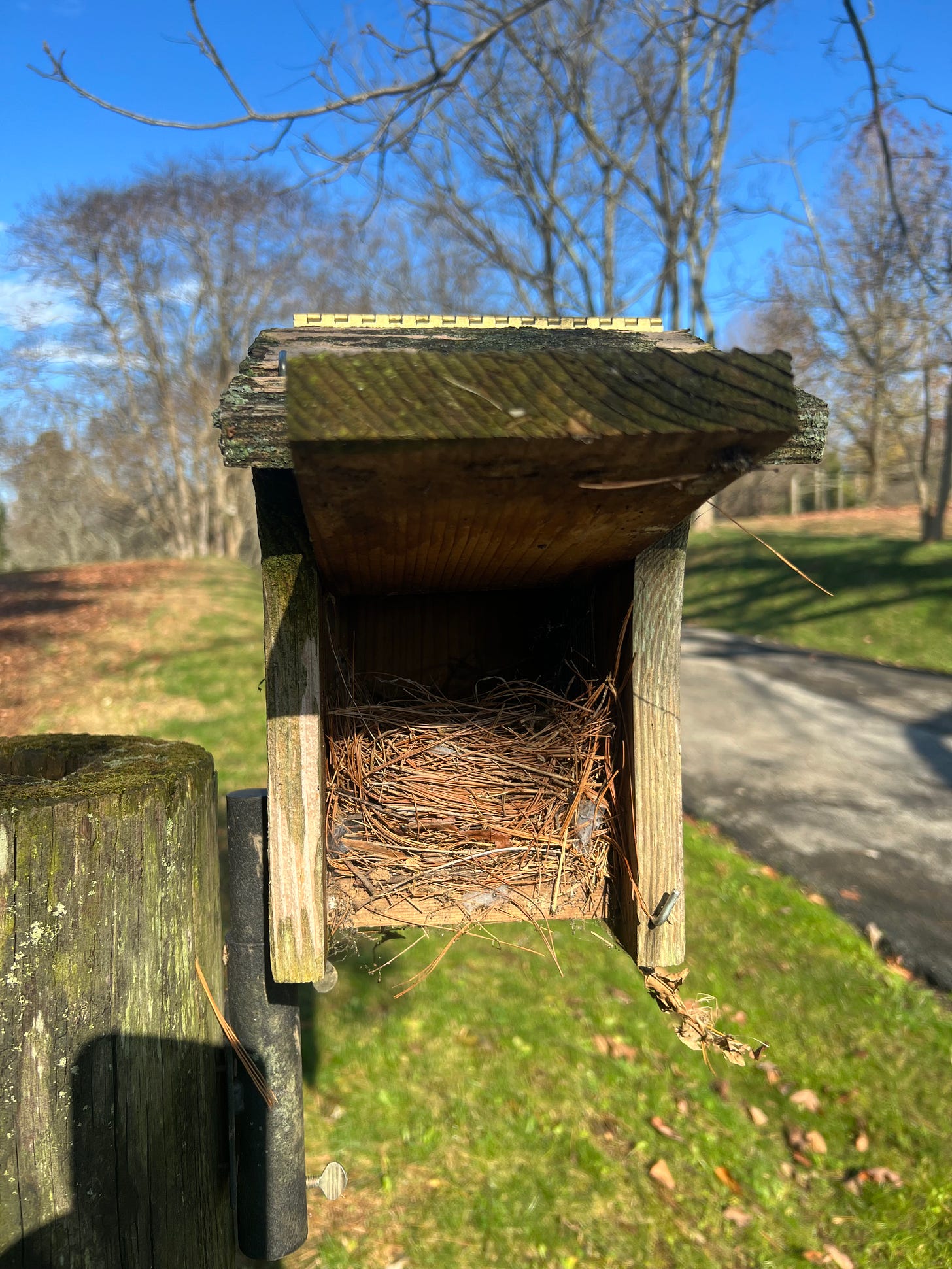Like most backyard gardeners, we don’t have the resources at Puddock Hill to measure our progress or regress by quantifying very many things. There is no team of entomologists to tally the arthropods. No expert bird counter to number the flock. No scientist to assess the soil. We mostly know how we’re doing through subjective anecdote and less than rigorous observation.
With birdhouses it’s a bit different. While I don’t monitor the boxes during nesting season, when I clean them out every November I can easily confirm the occupancy rate.
Well, easily but not 100% accurately, because there are some caveats. I don’t know how many times a given house was used over the year nor how many eggs were laid nor how many birds fledged. Nor do I know what to make of the occasional nest that just doesn’t look quite right to me. These are all things expert naturalist would track with precision.
But I do know how many nests I see every November when I open up our fourteen birdhouses to be cleaned. Usually, the occupancy rate hovers around two-thirds. This past year, it ran to 93%—with only a single unused birdhouse. I’d like to take credit for that progress, consider it the payoff from several years of assiduous backyard stewardship, but I also have to concede it might result from factors beyond my control.
We have attached birdhouses to old fence posts along the driveway and to the posts of our deer fence in places. In addition, we have several houses atop freestanding metal poles designed for this purpose. Most of the birdhouses are meant to attract bluebirds, and about half of them have done so. Here’s one just before cleaning:
All of the other occupied birdhouses seem to have attracted house wrens, which build their nests of sticks:
The house wren nests are so sturdy that I have to break them apart to remove them. I find it remarkable that these little birds drag so many sticks through the small hole afforded them and stack them with such skill and thoroughness.
Up until now, we have placed our birdhouses rather randomly. According to Cornell Lab of Ornithology, for example, Eastern bluebird houses should face east. While we do have some east-facing houses, we also had bluebirds build nests in houses facing south and even, in one case, west, into the prevailing wind.
The house wrens, which are listed by Cornell as a species in decline in our area, are said to be less picky about the direction their houses face. In total, our occupancy was about fifty-fifty between these two species (I know, I know, I should have counted exactly, but I was in hurry-up-and-clean mode). I’m glad to have signs that a species in decline seems to be doing fine at Puddock Hill.
With these fourteen houses established and mostly in use, I may be more judicious when adding boxes. While Cornell specifications for Eastern bluebird and house wren boxes differ somewhat in size of hole and placement off the ground, our house wrens seem more than happy with the boxes we have. Other species, however, would not be.
The American kestrel, for example, another species in decline, requires boxes placed much higher than those of the bluebird and house wren, and with larger holes. As do barn owls, of course. In future, I hope to add houses suitable for these and other species.
Cornell lists 59 species on their page of birdhouse advice, although not all these species nest in our area, and in some cases we do not have suitable habitat. For example, we’d love to host a purple martin nest, but our meadows are smaller than those that would attract them.
Another thing I should probably get better about is monitoring the birdhouses more carefully during the breeding season. Some species will produce a second brood if you clean the nest after the first brood has fledged. It’s entirely possible, I suppose, that a few of those occupied houses in fact provided backup accommodations for the same pairs of birds.
In any case, the bluebirds around here seem happy and relatively abundant. While writing this, I spotted several flying around outside, and I’d like to think they came to say thanks. More likely, however, they’re just hunting the last of the bugs.
We seem to live in fleabane heaven (Erigeron annuus). The place is thick with them all spring and well into summer. This late bloomer (or re-bloomer) attracted a solitary bee just last week:






We have an old wood duck box on a pole in the water on the big pond that I have been meaning to rehabilitate for a decade. It requires getting into a kayak and using tools. I'm probably better off just putting up a new one on land!
Regarding birdhouse styles, those with perches make it easier for predators and should therefore be discouraged. See this article: https://www.massaudubon.org/learn/nature-wildlife/birds/birdhouses
Your posting was an inspiration to “clean up” a half dozen bluebird boxes that over the years have been screwed and nailed shut on Keeler Hill. Unfortunately only 2 of the houses were salvageable and new ones will need to be acquired. And thank you for explaining that all birdhouses are not the same - some birds like the openings small and 4+ inches above the bottom of the box. While others require a perch at the entrance. I am not sure of their territory but perhaps a wood duck box or two would be appropriate for one of your ponds.
In any event, thank you for your posting.